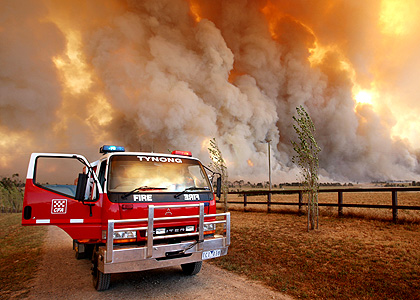Media incitement: ‘Come on baby light my fire’?
Monday, January 23rd, 2012“It will get worse before it gets better...Saturday, Sunday are going to be pretty extreme days once again. Temperatures will be at least in the low 40s.”
.
~ sound byte by Fairfax Media, Journalist Tim Young using a provocative sound byte from Dr Chris Ryan, Australian Bureau of Metereology at a media conference on Friday 6th February 2009..
Amongst the tragedies of the 2009 Victorian Bushfires – the catastrophic loss of 173 lives, many more people injured and traumatised, the massive loss of livestock and property, unmeasured fauna killed, and bushfire history repeating itself – was the excited media (and Victorian Premier John Brumby personally) dramatising on State television, newspapers and radio about an impending extreme bushfire risk.
Gippsland was already two weeks into a series of bushfires that were known to have been lit by arsonists – the Bunyip Bushfire and the Delburn Bushfire and these dominated the headlines. The media focus on the bushfires were about ‘scoops’ and sensational journalism. It had grown into a media infatuation. Every new bushfire story attracted headline news. To a dormant arsonist, such messages would have been a red rag to a bull.
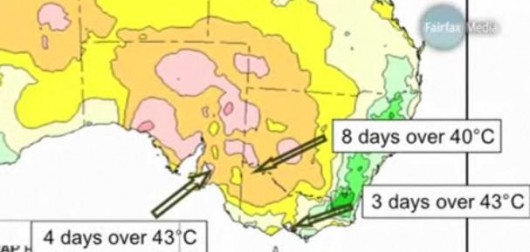 Record temperatures publicised with emphasis like never before
…on Friday 6th February 2009
Record temperatures publicised with emphasis like never before
…on Friday 6th February 2009
.
Victoria was in a severe long drought (like the 1983 Ash Wednesday Bushfires) with tinder dry bushland and extreme hot windy and dry weather conditions that the Victorian Country Fire Authority (CFA) had acknowledged as causing the forecast bushfire risk index for the coming weekend to fly off the scale.
Yet while the media and the Premier were effectively scaremongering, the CFA publicly stated that it was prepared for the weekend of 7th and 8th February 2009. This public confidence misleadingly lulled Victorians into a false sense of security and confidence in bushfire management business as usual, and contributed to the tragedy of long horrific day’s journey into night that unfolds.
The following media articles dated the morning of Saturday 7th February 2009 are reproduced here, the first a full double page spread in Fairfax’s ‘The Age’ newspaper on pages 4 and 5:
.
‘The sun rises on our ‘worst day in history’
[Source: ‘The sun rises on our ‘worst day in history‘, by Ben Doherty and Erdem Koch, The Age (morning newspaper), 20090207, ^http://www.theage.com.au/national/the-sun-rises-on-our-worst-day-in-history-20090206-7zzf.html]
 Grape grower Lou Bennett with some of his crop scorched in the recent hot weather.
He estimates about 30% of his crop has failed, burnt dry by the sun.
(Photo: Glenn Milne)
Grape grower Lou Bennett with some of his crop scorched in the recent hot weather.
He estimates about 30% of his crop has failed, burnt dry by the sun.
(Photo: Glenn Milne)
.
Today is likely to be among the hottest on record in Victoria, and the effects of the heatwave are adding up across the state.
The weather bureau tells Lou Bennett it’s 44 degrees (Celsius). But he trusts better his own thermometer, rigged up on the back verandah. It says 52.
It doesn’t really matter anyway, whatever the number, the sun feels oppressively, infernally hot, and he’ll be out in it.
Warnings from the Premier about today’s heatwave being “the worst day in the state’s history” don’t carry much weight with growers around Red Cliffs, near Mildura in Victoria’s north-west corner. There’s been plenty of tough ones already.
“Out on the farm it’s pretty hot, but whatever it is we’re out there in it,” Mr Bennett said. “Sometimes you’re lucky and you’re in the air-conditioned tractor, but most of the time you’re on the shovel or the motorbike.”
Straitened times have forced Mr Bennett to let his farmhands go. “Now I’ve got my kids coming out in 40-degree heat after school to help.”
By Mr Bennett’s count, today will be the 12th straight over 40 degrees at his place. It has sapped the life from his plants. He lost two complete hectares in one scorching morning, as well as about 30 per cent of his crop overall.
“It’s not just me, it’s everybody. It’s my neighbours, my friends. Your family suffers.”
Farmers across Victoria are suffering similarly. Growers in the Goulburn Valley are writing off crops of pears, apricots and apples ruined by sunburn.
In shearing sheds across the state, sheep have been passing out, overcome by the heat and the heavy fleece they’re carrying (a good rouseabout carries a bottle of water in hot weather to revive them).
Today is set to be the worst of the lot. Across the state, blistering temperatures are predicted, up to 46 degrees in the Mallee, while Melbourne will reach 44.
Northerly winds, gusting up to gale force at 100 km/h, will run across the state, with the potential to fan bushfires across tracts of tinder-dry land.
All sorts of records are being broken. Twelve straight days over 40 in the Mallee smashes the previous state record of nine days. By tonight, Melbourne will have gone 34 days without rain, the third worst dry spell on record.
The heat has also pushed the state’s morgue to its capacity. The Victorian coroner took in 50 bodies a day during last week’s heatwave — more than three times the average rate.
State coroner Jennifer Coate said yesterday that her office had to arrange for hospitals and funeral directors to store the bodies of people whose deaths required further investigation.
Imposing a statewide total fire ban for today, the CFA said the whole state was at extreme risk.
.
Premier John Brumby (on the Friday prior) warned that conditions were comparable to 1983’s deadly Ash Wednesday.
.
“It’s just as bad a day as you can imagine and on top of that the state is just tinder-dry,” he said. “People need to exercise real common sense … If you don’t need to go out, don’t go out, it’s a seriously bad day. If you don’t need to travel, don’t travel. Don’t go on the roads. If you don’t need to use the public transport system, don’t use it. If you can stay at home, stay at home.”
.
V/Line has told people not to travel to Gippsland unless they have to, warning that the Bunyip bushfire would likely disturb coach and train travel.
The Premier urged people to look after the elderly, infirm and vulnerable.
“Ring them … it’s going to be a terrible day for anyone who is ill or who is old,” he said.
Yesterday, the Federal Government issued a directive to nursing homes, requiring them to monitor 170,000 residents across the country. Nursing homes in Victoria and South Australia face spot checks and audits of their air-conditioning systems, following complaints.
Water Minister Tim Holding excused Victorians from their water saving for a day, saying people needed, above all else, to keep cool.
Water consumption peaked at 283 litres per person in Melbourne last Friday, when the temperature hit 45. The average for this summer has been 172 litres per person per day.
Power outages, which wreaked havoc across the state last week, are again a real possibility, with power companies urging people to prepare to do without electricity.
The peak of the extreme heat is likely to push the state’s power capabilities to their limit, while the afternoon change could bring winds that will bring down trees across power lines.
Victoria is preparing for the worst. Sport is being cancelled.
Two and four-legged competitors are heading for the shade. Cricket matches are being moved or called off, while the Classic Dog Show, which was to feature 1200 of Victoria’s most pampered and prize-adorned pups, has been cancelled.
Racing at Caulfield, including the Group 1 Orr Stakes, has been put back to Sunday. The only horses racing today will be at the non-TAB picnic meeting at Buchan in East Gippsland.
But punters with an itch to unload can still have a wager.
Online bookmakers are laying bets on just how hot it will be in Melbourne today.
However, no one’s betting against Lou Bennett summoning the courage to brave the heat, regardless of what the mercury tells him.
“You can’t stay inside, mate, you’ve got to get outside and get it done, because no one else is going to do it for you,” he says.
.
‘Town in fury over bush arsonist’
[Source: ‘Town in fury over bush arsonist’, by Chris Johnston, The Age, p.5, 20090207, ^ http://www.theage.com.au/national/town-in-fury-over-bush-arsonist-20090206-7zzj.html]
Most unnerving of all for Boolarra residents, is that whoever lit the fires may well be one of their own.
At the peak of the devastating Boolarra bushfires eight days ago it was, according to a local, like “a war zone without bullets”. Helicopters in the sky, panic in the streets. Sirens and explosions. The burnt-out shells where houses once stood.
The fires are now contained, but today’s extreme hot and windy conditions — tipped to be the worst in the state’s history — will be terrifying in this pretty village in Gippsland’s foothills.
It could all go up again. But they know that. They are ready. The firefighters have been working towards this day all week.
The deeper problem is something that no one really knows how to handle. The fires were deliberately lit and the close-knit community of 600 is seething. There are whispers of revenge and vigilantes, of bush justice. No one can believe anyone would do such a thing.
The talk is about how whoever did this must be a “sick bastard” and how they should be strapped to a tree in the next firefront and left to burn to “see how they like it”. Someone said that if caught, they would need police protection because the town wants blood.
“People and families here are scared and angry,” said Rob Herni, who grows tree ferns and chairs the local community development group. “And I don’t think there’s any reason for them not to be. Lives have been put at risk, homes destroyed, livelihoods gone. Plenty of people would want an hour or two with the culprits, I can tell you. Normally sane people threatening all kinds of things.”
The fires reached a peak last Friday. That was when they were coming on three fronts, the power was out and the drinking water was contaminated.
Thirty houses, 82 sheds, nine cars and a pig farm were destroyed in 6500 hectares around Boolarra, Mirboo North, Darlimurla and Yinnar, all in the Strzelecki Ranges south of Morwell. That no one died either fighting it or caught in it is seen by the community as a miracle.
Police yesterday announced a new taskforce to investigate the fires and said the driver of a dark silver or grey Toyota Hilux single-cab utility could be the firebug after such a vehicle was seen at the ignition points. Two men were questioned last week but released. The Age believes they were apprehended at the Boolarra CFA staging ground last Thursday, but were not CFA members. A $100,000 reward has been posted.
Boolarra CFA captain Todd Birkbeck believes he knows how it played out. His pager went off at 7.30am last Wednesday; a fire had been lit in the forested hills behind the Boolarra goldfish farm. It was put out but lit again later that day. The next day, he said, another was lit near a track off Creamery Road, near Yinnar, and another at Lyrebird Walk, near Mirboo North.
“By last Thursday night the three had joined up,” he said. “That was the problem. There was no lightning. Fires don’t light up on their own.”
His wife, Michelle, said she and most others were anxious, paranoid and on edge. She heard a motorcycle out in the trees one night, when the fires were out, and feared the worst. It was someone checking fences.
“It’s surreal,” she said. “Nervy. Everyone’s jumping at shadows. You could be talking to them, you don’t know. You see a stranger and you wonder. It’s horrible.”
Mr Herni said he was paranoid about having to drive some mower fuel home to Boolarra from Yinnar today. “Does that make me an arsonist?” he asked. “In the eyes of others?”
The most difficult thing for people to understand is that the arsonist may well be one of their own. Forensic psychologist Rebekah Doley, Australia’s only criminal profiler of bushfire arsonists, said most lived within 10 kilometres of the scene.
“They have knowledge of the landscape and they know where to set the fire best to achieve what they want,” she said.
The culprit was likely to be a male loner with a dysfunctional background who lit the fires to exert power over a community in which he felt powerless.
“They need to assert themselves in some way and fire is a very universally powerful tool to do that so it’s about the experience of the fire rather than setting the fire itself,” she said.
She said serial arsonists were common and the Boolarra firebug could strike again.
“They have to demonstrate they still have the power even if they know police are on their tail.”
She said a serial arsonist was someone with a “deep-seated, long-term interest in fire” who used it as coping tool to relieve emotional tension.
A recent Australian Institute of Criminology report into bushfires said they cost the country $1.6 billion a year and half — about “20,000 to 30,0000” — were deliberately lit.
All this is unthinkable to the people of Boolarra. It has happened to them before — and in the towns nearby like Churchill — but it never makes sense. They live in the trees here, in a village, a hidden valley. Why would someone destroy that, why tear the community apart? With fire, of all things.
“I don’t have any of the answers,” said Rob Herni. “All I know is that people are scared. There’s a lot of fear, real fear. Where are they going to light a fire next? And when?”
.
Read Reports by the Australian Institute of Criminology
(Each 150kb)
[1] >The Cost of Bushfires (AIC, 20041123).pdf
[2] >Firefighter Arson Pt1 (AIC 20050607).pdf
[3] >Firefighter Arson Pt 2 (AIC 20050621).pdf
.
.
Editor: Early Afternoon of Saturday 7th February 2009 – the reports start coming in…
.
‘Fire crews retreat as strong winds fuel flames’
[Source: ‘Fire crews retreat as strong winds fuel flames’, by Robyn Grace, AAP, 20090207, ^http://www.theage.com.au/national/fire-crews-retreat-as-strong-winds-fuel-flames-20090207-806a.html].
The Country Fire Authority has issued a number of urgent threat messages as fire activity increases throughout the state.
Ground attack firefighters were earlier forced to retreat from a bushfire burning through the Bunyip State Forest east of Melbourne after the blaze broke containment lines.
Emergency authorities were forced to pull their ground crews out of the fire ground in the Bunyip State Forest, near Pakenham, this morning because of the escalating risk as forecast strong winds began blowing through the area.
Authorities have warned power supplies may be at risk as bushfires near power lines.
Officials also warned people to stay away from the forest area after recreational four-wheel drivers and trail bikers were spotted heading into the state parkland.
“We put road closures in place because unfortunately we’ve had people who’ve tried to go out into the bush early this morning,” incident controller David Nugent said.
“We have got some closures in place in areas like Bunyip State Park. We had people go out there this morning, which is really disappointing to us. It’s not a very good idea to be out in the bush today, particularly around the fire area where we are trying to do our work on the fire.”
More than 100 firefighters are desperately working to contain the fire in Bunyip State Park as it nears a number of small townships.
The fire broke through containment lines about 3am today and crews now fear the worst as the humidity drops and winds reach predicted levels.
Victorians were yesterday told to brace for its worst day in history with 44-degree heat, gale-force winds and tinder-dry conditions fuelling the fire threat.
“Everything is going according to predictions unfortunately,” Department of Sustainability and Environment state duty officer Stuart Ord told Sky News about 8am.
Firefighters worked in shifts overnight to try to contain the fire near Pakenham in Melbourne’s east.
After the blaze broke control lines overnight, DSE crews were forced to retreat because of the escalating risk and difficult terrain.
Mr Nugent said the change in tactics meant only aircraft crews were deployed to waterbomb the 165-hectare blaze in an effort to limit its potential, before weather conditions took a forecast turn for the worse.
The communities of Labertouche, Jindivick West and Tonimbuk are now on high alert as winds push the blaze in a south-easterly direction.
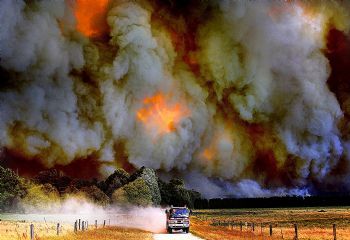
The fire is spotting in multiple areas. The Country Fire Authority said the fire was not currently posing a threat but activity had increased and it had the potential to impact on towns directly.
Residents have been warned to expect increased smoke and embers within the next two hours. They have also been told to be prepared to activate their bushfire survival plans if necessary.
Mr Ord said flames were 10 metres tall in some parts of the fire. Dry lightning in other parts of the state were also a concern, he said.
DSE incident controller David Nugent said fire crews had worked tirelessly in an effort to minimise the anticipated spread of the fire.
“Our bulldozer operators have worked non-stop to build control lines around the fire edge and this effort has been greatly enhanced by the work of firefighting aircraft,” Mr Nugent said.
Firefighting aircraft included the Elvis Erikson aircrane, fixed-wing aircraft dropping retardant on the perimeter of the fire and two medium water-bombing helicopters.
Mr Nugent said the power easements supplying Melbourne and other parts of Victoria remained a key issue.
Melbourne Water has released extra water into the Taraoo aqueduct to fight the expected fires.
CFA spokesman Paul Little said a forecast change in wind direction later today could mean the fire front grows from one or two kilometres to several kilometres in width, creating more challenges for fire crews trying to contain the blaze and protect assets.
“Right now, we’ve got crews strategically placed around Labertouche and other areas ready to respond,” Mr Little said. “But what happens later … we’ll have to wait and see. If the wind changes direction, we’ll have a small firefront grow into a massive firefront and that won’t be good.’‘
The rest of south-east Australia is also gearing up for a horror weekend of extreme heat and bushfires.
In Adelaide, the temperature is expected to peak at 41 on Saturday with the mercury in some South Australian country areas tipped to go even higher.
Tomorrow, temperatures are likely to top 47 degrees in parts of NSW.
The CFA advises:
- Tourists are advised to avoid the following areas: Bunyip State Park, Kurth Kiln Regional Park, Tarago Forest and surrounding areas.
- Road closures currently in place: Intersection of Beenak Road and Launching Place Road, intersection of Princes Freeway and Tynong North Road, intersection of Princes Freeway and Bunyip Road, and intersection of Forest Road and Labertouche North Road.
- Emergency relief centres are located at: Warragul Leisure Centre.
For information on fires in Victoria and general fire safety advice, contact the Victorian Bushfire Information Line on 1800 240 667. Callers who are deaf, hard of hearing, or have a speech/communication impairment may call textphone/ telewriter on 1800 122 969. Information is also available at www.dse.vic.gov.au/fires.’.
.
‘Death toll may reach more than 40: police’
[Source: ‘Death toll may reach more than 40: police’, 20090207, AAP, ^http://www.theage.com.au/national/death-toll-may-reach-more-than-40-police-20090207-80ao.html]“Email your photos to scoop@theage.com.au”
.
Fourteen people have been killed in the savage bushfires which set Victoria ablaze today. Victoria police confirmed the deaths tonight and said they fear the figure may be more than 40.
At least 100 homes have been destroyed as nine major blazes burnt out of control across Victoria in the worst fire conditions in the state’s history.
Deputy police commissioner Kieran Walshe said all the deaths were in a massive blaze northwest of Melbourne – six at Kinglake, four at nearby Wandong, three at Strathewen and one in Clonbinane.
Mr Walshe said he believed the Kinglake victims were all in the same car. He believed arsonists were responsible for some of the nine major fires ripping across the state.
“We suspect a number of the fires have been deliberately lit,” Mr Walshe told reporters. “This is an absolute tragedy for the state and we believe the figure may even get worse,” Mr Walshe said. “We base that on the fact we’re only just getting into these areas now … to search buildings and properties these have been very very significant fires … the figure could get into the 40s.’‘
The fire started in East Kilmore, 80km north of Melbourne, and covered a huge area as it pushed 30km east to Kinglake, through the small townships of Wandong, Strathewen and Clonbinane.
Mr Walshe said he could not determine whether the victims were civilians or firefighters. He said identifications could not be carried out until at least Sunday. One man, aged in his 40s, is in critical condition after suffering burns to 50 per cent of his body when he tried to move stock in the Coleraine area in the state’s west.
More than 3,000 firefighters and many more residents battled major fronts at Horsham, Coleraine, Weerite, Kilmore East, Bunyip, Churchill, Dargo, Murrindindi and Redesdale in all corners of the scorched state as the searing heat in the mid 40s and high winds exceeded authorities’ predictions of the worst fire conditions in the state’s history.
The Kilmore region in the north and several areas of Gippsland in the east were on high alert as an uneasy dusk fell on Saturday night, while the Horsham fire was downgraded early in the evening.
Fifty houses were reportedly lost in the Bendigo area in the Redesdale blaze and up to 30 houses went up in the Kilmore fire which pushed across Whittlesea and into the town of Kinglake, northwest of Melbourne, which one resident said had gone up in flames.
“The whole township is pretty much on fire,” Peter Mitchell told ABC Radio.
“There was was no time to do anything … it came through in minutes. There’ll be a massive loss of houses … There’ll be a lot of us homeless. All those who have made it into town will be fine. The others will be sheltering and working on their fire plans, God help them.”
Mr Mitchell said he was with around 200 residents holed up in the local pub and that no fire trucks could get into the town.
Thousands more residents in the region were sheltering wherever they could find cover as they were warned the worst was to come overnight.
A cool change early this evening did not bring any respite but, in fact, was expected to create more volatile conditions.
“It hasn’t helped the firefighters, only presented them with new fronts,” the Country Fire Authority (CFA) spokeswoman said.
The CFA and DSE (Department of Sustainability and Environment) warned Victorians to prepare to be hit by fire late tonight and to be especially prepared for ember attack.
“You should assume that as the wind change comes through, that your property could be impacted,” CFA State Coordinator Geoff Conway said.
La Trobe Valley power stations were under threat as a fire on the eastern fringes of the Strzelecki Ranges spread toward the Gippsland coast, threatening towns such as Yarram, Langsbrough and Manns Beach.
“It is pretty well every part of the state except the far northwest,” CFA Deputy Chief Fire Officer John Haynes said.
The Horsham fire burnt 5700 hectares and claimed at least three homes, the town’s golf club and several sheds.
The Bunyip State Park reached 2400 hectares, and one at Kilmore burned 2000 hectares.
CFA deputy chief fire officer John Haynes said it would be about midnight, after the cool change had swept across the state, before fire fighters knew whether they had got on top of the blazes.
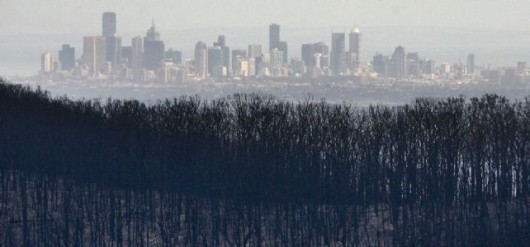 Melbourne: a wealthy growing city, neglecting Regional Victoria
Melbourne: a wealthy growing city, neglecting Regional Victoria
.
“Our guys have been flat out trying to fight the fires and trying to pin them down a bit,” Mr Haynes said.
.
“The fire weather … was extreme and off the scale.”
.
By 6pm, at least one house was destroyed at Coleraine in Victoria’s west, in Melbourne’s southeast three homes were destroyed at Lyndbrook; and north of Melbourne six houses were destroyed at Wandong and one at Whittlesea. Homes were also lost in Labertouche, near the Bunyip State Park east of Melbourne.
“There will be more to come,” Mr Haynes said. Julie Venrooy said from Shady Creek, east of Melbourne, said she had been forced to stay on the Princes Highway south of Tonimbuk by police, unable to return to her home. “I’ve been able to contact my husband once. He’s had ember attack, that was about an hour ago but I don’t know what’s happened since,” Ms Venrooy said.
Victoria Premier John Brumby said one fire threatening his parents’ home in Coleraine was stopped literally on their doorstep.
“I would like to thank DSE, CFA and SES (State Emergency Services) fire fighters and volunteers who have fought tirelessly throughout the day to protect Victorian people and property,” Mr Brumby said.
The fires came as Melbourne reached its hottest ever temperature of 46.4 degrees (Celsius), while nearby Avalon recorded the state’s high of 47.9 (Celsius).
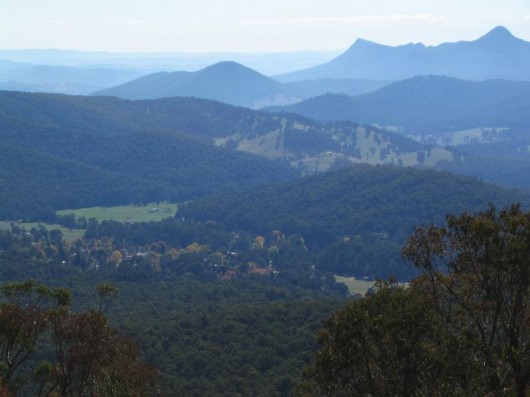 Remembering Marysville and indeed, Regional Victoria
Remembering Marysville and indeed, Regional Victoria

